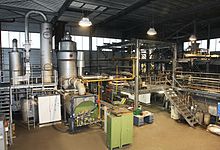Holthausen waterworks
The Holthausen waterworks is the youngest of four waterworks in the Düsseldorf area. It is located in the south of Düsseldorf . It is operated by Stadtwerke Düsseldorf .
history
In 1963 the Holthausen waterworks was built and went into operation in 1964.
When the “economic miracle” began, the obligation to always supply impeccable drinking water posed problems for Stadtwerke Düsseldorf after a short time. Due to water seeping into the gravel and sands of the floodplain, the quality of the water in the wells deteriorated rapidly with the increasing pollution of the Rhine from 1949/50 . However, as analyzes from 1961 show, the well water always differed greatly from the Rhine water - thanks to the excellent natural filtering in the soil. Already in the twenties and thirties there was an increasing sewage pollution of the Rhine and a gradually rising chloride contentbeen found. Nevertheless, the well water remained drinkable without any treatment. Then the smell and taste of the water increasingly deteriorated. Industrial plants and cities led more and more wastewater into the Rhine. Of all the water treatment methods tested, the one with activated carbon and ozone worked best. In 1962 the construction of the water treatment according to the "Düsseldorf treatment process" began in Holthausen . It should treat the raw water pumped by the community waterworks "Auf dem Grind", which was previously mixed with chlorine and fed under the Rhine through two culverts into the Düsseldorf city network. In 1964 the first stage of water treatment was commissioned.
Because of the pollution of the Rhine in the seventies, the treatment to drinking water was further improved in accordance with the increasing requirements and the facilities were expanded. In the Holthausen processing plant, ozone and 12 activated carbon filters ensured consistently good quality from 1964.
In 1975, the Holthausen waterworks was expanded to include a second expansion stage for water treatment.
The more the quality of the extracted water deteriorated, the more often the coal in the three waterworks had to be renewed. In the first few years, the manufacturing plants took care of the regeneration, which was not only expensive and time-consuming, but often also led to waiting times. That is why the municipal utility soon considered its own reactivation plant. Holthausen was chosen as the location. Construction began in spring 1975, and in August 1976 the first batches of activated carbon were reactivated on a trial basis. The amount of activated carbon reactivated in Holthausen in 2012 was 3150 m³.
Also in 1975, the first pumping station in Holthausen, exclusively used for the supply of domestic water, which was built for the Henkel company , went into operation.
In 2009 a test facility was built at the Holthausen waterworks. It tests various processing technologies and stress situations. Over the next few years, these activities are intended to answer the question of which operating mode and process combination can be used to make the process fit for the future in order to provide clean drinking water for customers in an efficient and economical manner.
processing
Approx. 21,634,000 m³ / a in the Holthausen waterworks. The first stage is bank filtration. The second stage is oxidation by ozone : 0.5 g / m³, ozone generation from oxygen. Step three: pre-activation by means of activated carbon filtration in a closed construction, grain size: 1.5 - 2.5 mm, area: 20 m², height: 1.5 m, throughput: 200 m³ / h. Stage four is activated carbon filtration in a closed construction, grain size: 0.8 - 2.4 mm, area: 20 m², height: 2.5 m, throughput: 200 m³ / h. (Previously level 5: disinfection with chlorine dioxide : 0.05 g / m³.) And finally level five: Inhibitors with phosphate : 1 g / m³ (previously also silicate: 1 g / m³). (As of 2016).
Coverage area
The drinking water supply area of the Düsseldorf waterworks comprises 600,000 people, trade and industry in Düsseldorf, Erkrath and Mettmann . In total, around 50 million cubic meters (m³) of drinking water are distributed in one year, which is an average of 140,000 cubic meters - 140 million liters per day. The daily charge varies between 120,000 cubic meters in winter and up to 250,000 cubic meters on a hot summer day.
Web links
- From raindrops to the tap
- Drinking water treatment & supply
- Current drinking water analysis by Stadtwerke Düsseldorf
Individual evidence
- ↑ Rüdiger Furrer, Michael Fleig and Heinz-Jürgen Brauch - PDF: Water Pumping and Treatment in the Rhine Catchment Area - IAWR. (PDF; 2.7 MB) (No longer available online.) Archived from the original on March 11, 2014 ; accessed on March 11, 2014 . Info: The archive link was inserted automatically and has not yet been checked. Please check the original and archive link according to the instructions and then remove this notice.
- ^ Stadtwerke Düsseldorf: Düsseldorf drinking water treatment and supply. Retrieved September 26, 2016 .
- ↑ Stadtwerke Düsseldorf: Clearly drinking water - basic material of life. (PDF) Retrieved September 26, 2016 .
Coordinates: 51 ° 9 ′ 44 ″ N , 6 ° 49 ′ 25 ″ E


